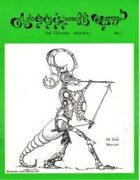
Filled with legitimately innovative game mechanics, it provided a combat system the rabbits were very ill-advised to use, as well as a skill system hampered only by the fact the rabbits were, well, as smart as rabbits. Dennis Sustare and Scott Robinson’s Watership Down-inspired Bunnies and Burrows, in which you play a rabbit, a tasty, tasty rabbit. In most games, the PCs are functionally apex predators. Fiest, which drew heavily from the Tekumel setting for Barker’s Empire of the Petal Throne (Doubleday 1982, cover by David Gatti) The Man of Gold and Flamesong by M.A.R Barker (DAW 19, covers by Michael Whelan and Richard Hescox), and Magician by

As result, more people were exposed to his ideas via the unauthorized version offered by Raymond Feist. There were definitely parallels between the two authors, the main difference being that Barker was, uh, more of an ideas man than a prose man. In the 1980s, DAW gave Barker his shot at being the next Tolkien. Original TSR boxed edition of Empire of the Petal Throne (1975)

While it had (and has) its avid fanbase, the game never caught on in a big way. The synergy between a complete game world and early RPGs was obvious as a result TSR was one of many, many companies to try their hand at publishing it. Professor Muhammad Abd-al-Rahman Barker’s world of Tekumel predated roleplaying games by decades. Barker’s Empire of the Petal Throne, one of or possibly the first complex, non-faux Medieval European settings for an RPG.

Here’s a more pointless variation: the first ten interesting RPGs I acquired but never found players for. Empire of the Petal Throne (PDF version of 1975 TSR edition), Bunnies & Burrows (Frog God Press, 2019), and Stormbringer (Chaosium, 2nd edition, 1985)


 0 kommentar(er)
0 kommentar(er)
